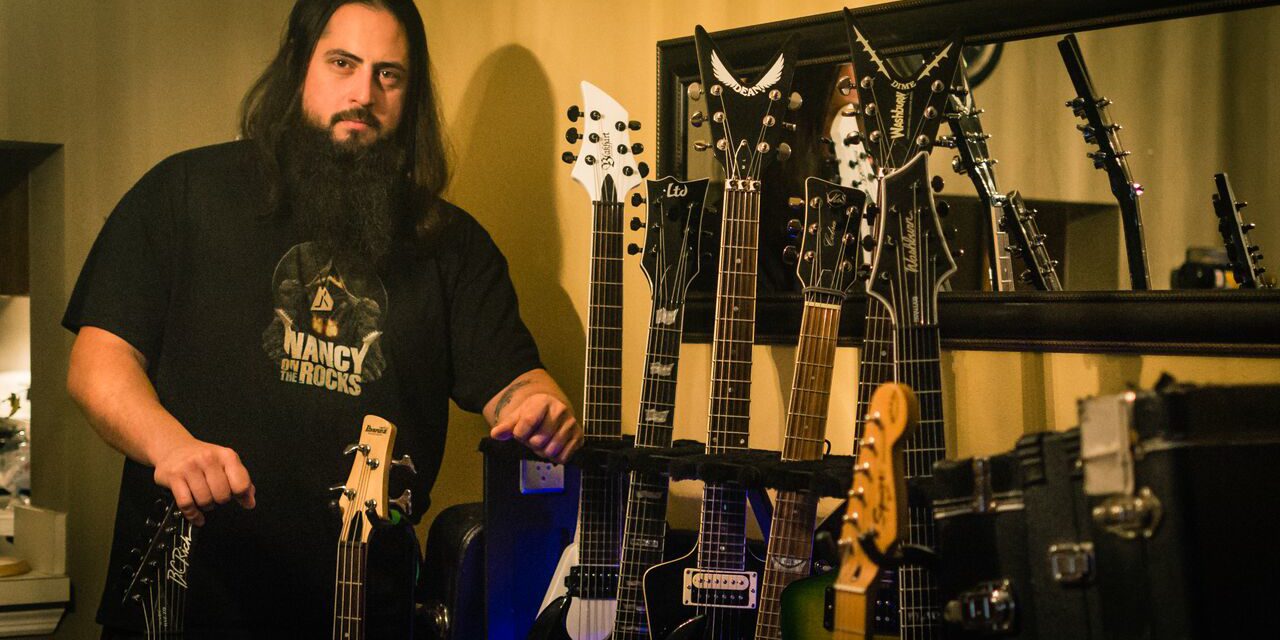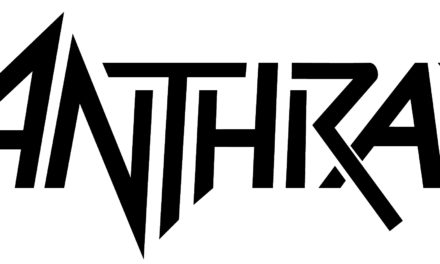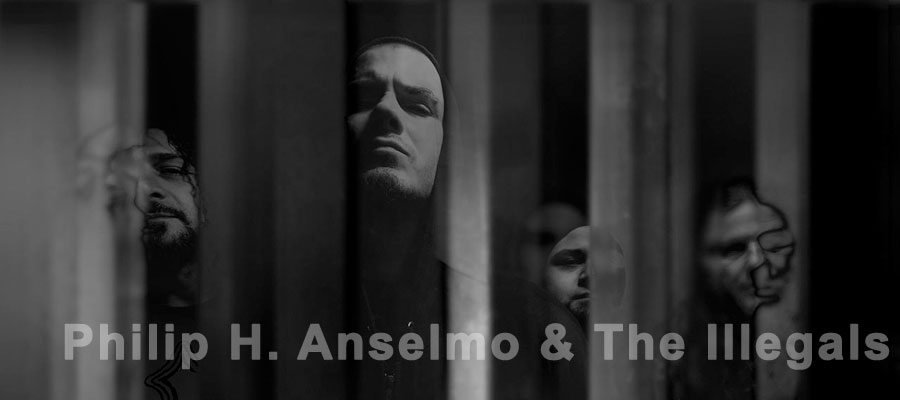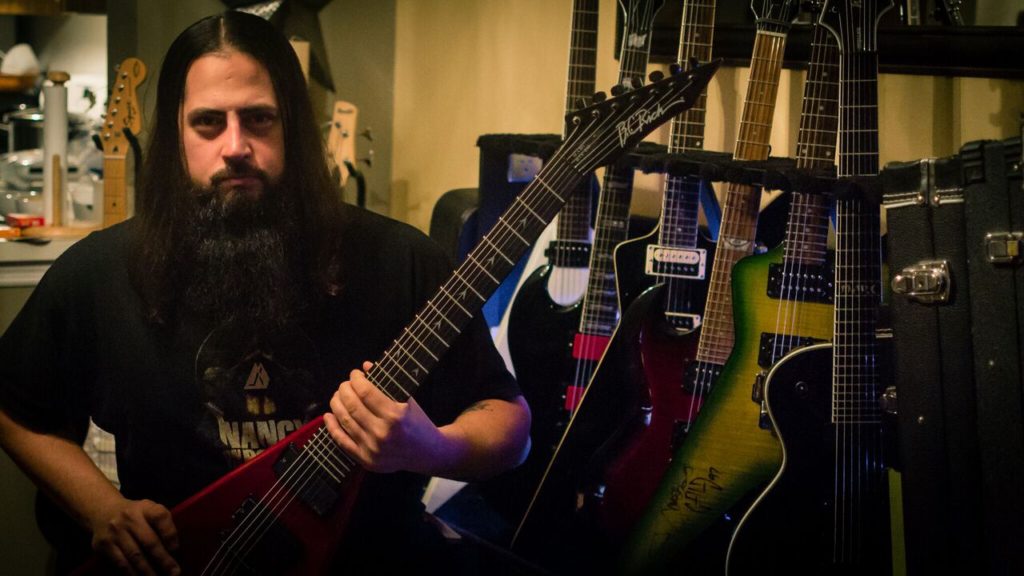
Andres Lecaros
Story and photos by Barry Nadler
Lecaros is based out of Orlando, FL, but originally hails from New Jersey. Between touring with Marc Rizzo of Soulfly and working with Gus G, on the 70,000 Tons of Metal cruise, he took a little bit of time to sit down with UnRated Magazine and share some of the experience of being a guitar tech for a touring band, as well as offer some advice to people that want to become guitar techs for a living.
Andres Lecaros on Facebook | Andres Lecaros Instagram
What Exactly is a Guitar Tech?
A guitar tech and a roadie or stage hand are essentially the same thing.
Being a guitar tech is like being the butler for a guitar player. The role covers maintenance for the guitars, as well as assisting the person or band for whom you are working. Basically, you take care of the guitar player.
At the bare minimum, the guitar tech’s job is to change strings and tune the guitars. But, beyond that, the job can include cleaning and intonating the guitars, as well as tuning the guitars between shows.
A guitar tech is also responsible for setting up the stage for them with their cabinets, racks, in-ear monitors, pedal boards, and other gear they may have.
You might even be responsible for doing the sound check for them. “Whatever band I work for, I learn a few of their songs they would be playing in the set or tour. I then make sure the other techs (drums and bass) also know some of those songs. This way, we can jam these songs for the front-of-house guy.”
During a show, I will watch the guitar player play the song the way he plays it live. I then mimic it and play the parts I know. Then, my role is to make it sound just like a show would. This gives the sound guy a good sound check for the show.
The tech is also responsible for the load-ins that occur every day of the show.
What is a Day-in-the-Life for a Guitar Tech
This is a rundown of a day with Soulfly on a typical US, Canada, or Europe tour. This all changes when you get into situations where there are fly-dates in places like Moscow, Dubai, Turkey, or South America.
Tours start out of Phoenix, AZ because that is where the band is based out of. The team takes the tour bus to Phoenix and load up the trailer with all the gear for the tour. Then, everyone selects their bunk in the tour bus.
The band and crew take the bus from Phoenix to the first stop of the tour. The goal is to be at that stop by 11:00 AM on the day of the show. At noon, the techs start the load in process. Usually there are two-four stagehands from the venue to assist bringing the gear in. The stage manager selects the side he wants to be on for the singer. Then, the tech team builds the stage from there. Once the manager decides his side, the guitar tech takes the opposite side. Cabinets go up first. “I do this by putting myself where my guitarist would stand and then put my cabinets behind him.” For Soulfly, normally, there is a drum riser. The singer has split cabinets that butt against the riser – on each side of the riser. Then, Marc Rizzo goes on the side Andres chose and the bass player goes on the other side. Once that is in place, Andres goes on the hunt for the best place to stand during the show. He like to watch the guitar player because that gives him immediate notification if he pops a string. This allows him to run and get the second guitar (which is typically located right next to Andres’ work area). He can tune it up real quick and provide it to him. If there is no room on the side of the stage, he stands behind the cabinets and setsup there.
Soulfly has a rack with two guitar heads. They put all the pedals on top of the heads. As his tech, Andres runs all his pedals. For example, if Rizzo needs a delay, Andres will turn on the delay for him. The only pedal Marc Rizzo has on stage is a wah pedal up front. All the other effects happen from behind the cabinets. Some guitar players have techs that run everything through racks of pedals for them. There are others that don’t want to rely on someone and prefer to do it themselves – they have it all on a large pedal board. Steve Vai likes to run his own, for example. He has a huge pedal board up front and performs all his changes for himself.
Once the crew is done setting up, Andres performs a small sound check to verify the rig is in working order, as well as check the acoustics in the venue. Some venues are concrete wall, while others have textured walls, which can dampen the sound or make it slap back at you in a way that just disintegrates the sound with no reverb or echo. Wooden, concrete, or carpeted stages all affect the sound also. This means you may have to tweak EQ’s to make sure it sounds the way your guitar player likes it.
Once this all occurs, the front-of-house guy comes along and starts setting up all the mics on the guitar cabinets, singer cabinets, and the drums. Sometimes, Andres jumps in and helps him run cables to speed this portion up. This might include patching cables to the stage box. While this is happening, the goal is to be all tuned up and ready for sound check.
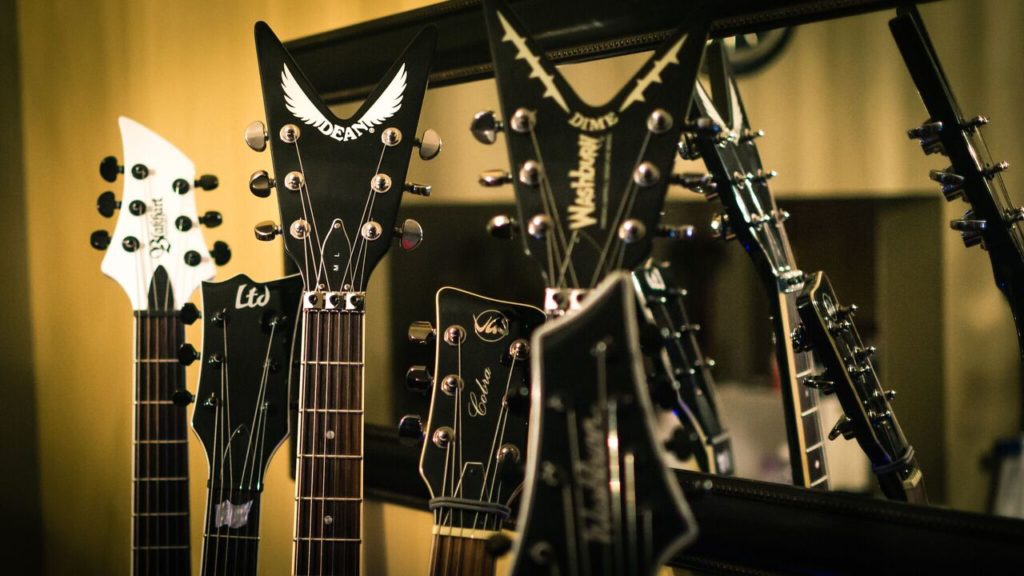
Sound checks usually go in a specific order that is standard across all venues and driven by the front-of-house operator. It is always drums first. Then, the bass. Guitars are last in the sound checks for the instruments. This is so the different volumes can get set for the monitor wedges on the stage in the order they get needed for stage volume.
Once the individual sound checks happen, the entire band does a sound check together. If the band isn’t available or doesn’t want to do the sound check for some reason, the techs perform in their place. If, for some reason, nobody knows what song to do, the techs perform what is called an “open chug.” It is a standard, open E string muted – Chug, Chug, Chug, Chug. The drummer supplies a simple beat to accompany the “chug.” This allows everyone to hear the mix. While this happens, the sound guy dials in the on-stage monitor wedges. The goal is to hear everything at a decent level.
Once sound check is done, guitars go into the guitar boat, they roll up cables, put away pedal boards, and the sound guy will repeat this process for the next band. While this is happening, Andres starts tuning guitars. Usually he has two guitars to change out. “Rizzo likes to go three, sometimes four shows without changing strings.” He points out that this changes based on the guitar player with whom he is working. For example, Gus G, of Ozzy Osbourne, likes to change strings out for every show. Bobby Keller, of Meka Nism, changes them out the day before each show – but he uses four different guitars.
After the guitars are all tuned, which is quite a large process, it is time to get something to eat and wait for show time. Most of the time, all of this is completed by 2:00 or 3:00. The band and crew can use this time to also go and enjoy a little of the town. This is obviously dependent on the load in time.
Once the show starts, about 30 minutes before Soulfly would hit the stage, the previous band is usually finishing up. Andres and the other techs assist in getting the other bands gear off the stage. Then, after Soulfly is set up and ready, they perform a “line-check.” This is a quick couple of notes on each instrument for the sound guy to verify everything is ready.
Once the show happens, there is a drum solo built in about half-way through the show. At this point, Andres helps his guitarist relax and hydrate. He also wipes all the sweat off the guitar, so it is easier to play. This is a tedious process – you need one rag to wipe the sweat, another to oil the guitar, and a third to wipe the oil off the guitar. This also shines up the guitar for the second part of the show. This process includes de-oxidizing of the strings and frets. This makes the strings more slippery, so the guitar player can better perform slides. Lastly, he also re-tunes the guitar. This all occurs in a time span of about three to five minutes. According to Andres, Marc doesn’t like to switch guitars because even if they are the same guitar model, they still play different. No two guitars play the same.
Once the show is over, it becomes a “hurry up and pack” situation. The goal is to make sure everything is put away nicely though. In this process, the guitars and strings get wiped down and packed into cases. Then, he performs load-out and assists the other techs if necessary. This is typically the drum tech because drums are the biggest and take the most time. Once everything is set, the assembly line begins.
Someone goes to the trailer, opens it, and stays there. Another tech stays on stage. A third tech is in between the two. This is mainly to prevent gear from getting stolen, because there are always eyes on the gear. The lead tech determines the order in which gear gets packed. Essentially, the trailer is a puzzle, with the gear being the pieces. The other part of packing the trailer has to do with the distribution of weight. If you don’t, you could cause an axle to become damaged.
If you have time before the bus call, you might go take a quick shower. At that point, everyone gets on the bus and talks about the night or just messes around. There is usually a beer or two involved.
Once the bus driver turns on the bus, the crew goes over the day sheet for the next day. This day sheet consists of the band name, the date, the venue, load in time, how many bands on the bill, set times, if it is a buy-out or are meals provided, and final bus call for that night.
If you are not at the bus at the established bus call time, the bus will leave without you. As Andres knocks on the wooden table he states “It hasn’t happened to me yet. Almost…but not yet!” According to him, it has happened to others. When this happens, they are responsible for paying to get themselves to the next show – which can get expensive.
The next day…you do it all over again.
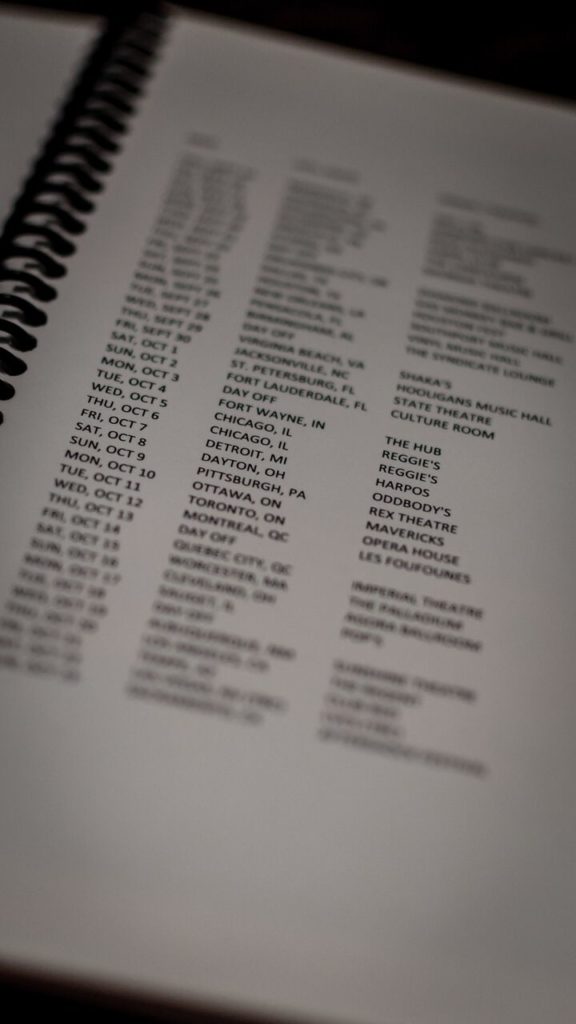 What Happens if There Are Fly Dates Involved?
What Happens if There Are Fly Dates Involved?
If there are fly-dates, they fly as early as 6 AM to the next country. For example, if they are traveling from Argentina to Chile, they might fly out of Buenos Ares. They might leave the hotel around 4 AM to get to the airport by 4:30 AM or so. The plane might leave around 7AM. The band and crew would arrive in Santiago, Chile and gather all baggage, which includes personal luggage and two pieces of gear each. For Andres, it is one guitar and maybe a cymbal case or extra case of some sort. Marc Rizzo would take a guitar, as well.
There is usually a van waiting. He describes this van as a minivan with twelve seats. After everyone crams into this van, the equipment goes to the venue and the crew goes to the hotel. While there they will drop stuff off and take showers. They quickly eat something. By 1:00 they meet in the lobby and are ready to go to the venue. The guitar crew brings along cables, pedals, and guitars. The drummer brings his pedals, cymbals, and sticks.
Once the show happens, they load out and go back to the hotel. While there, they pack up, shower, and get up early in the morning, and get on another plane to do it all over again.
Andres shares that they did a month-long tour in South America and followed this schedule for the whole month. He admits that it was very exhausting.
How Did You Become a Guitar Tech?
In 1999, he moved from Orlando back to New Jersey. In 2000, he started with a band that played original music. The drummer introduced him to a band called Ill Nino, who were playing a local show. His drummer knew the singer and the guitar player. After the show, they were hanging out and Andres happened to say “Hey, you guys need a guitar tech?” Oddly, at that point, Andres was not familiar with what a guitar tech really was. “Yeah! We need a guitar tech!” He proceeded to go home, pack his stuff, and became their guitar tech.
After five years, he stopped and got into firefighting and culinary work – hence the “chef Andres” in his Facebook name. He got back into being a guitar tech around 2013. All told, Andres has been a guitar tech for eight years.
Who is Your Dream Guitarist to Work For?
Andres’ immediate answer to this question is Dimebag Darrell, of Pantera. However, he is no longer with us. His second choice would be to work with Gary Holt, of Exodus. Third would be Danny Spitz, formerly of Anthrax.
What were Your Influences and What Got You interested in this Career?
When Andres was 11 years old, one of his brothers played in a band. His older brother was around 21 years old at the time. His show was the first concert Andres ever saw. This was at a high school in New Jersey. It was all spandex pants, boots, and big 80’s hair. During the show, his brother slipped and fell. He played it off by rolling around on the floor and spinning. Lecaros says he will never forget that.
Andres’ first actual concert was Anthrax and Ozzy Osbourne. Anthrax was on their State of Euphoria tour and Ozzy was supporting No Rest for the Wicked. His father took him to see this show in New Jersey. He was about 13 at the time of this show. A woman told him not to take his glasses because there might be a mosh pit and you can lose your glasses. “I was like alright…cool! No problem.” He had no idea where he was sitting in the show – he was only 13 years old. It turns out he was at the back of the arena – nosebleed seats. So, he is at this show and he can’t see because he doesn’t have his glasses. He can’t even see the stage. Before the show starts, his father says “Look! Over there! There is a naked girl running up the stairs!” Andres was thinking “Yeah, I can’t see a thing!” However, he still enjoyed the show. This was the beginning of a love of metal for Andres.
As a youth, his best friend, introduced him to a lot of bands and guitar players. Some primary influences were Stevie Ray Vaughn, Dimebag Darrell, Alex Skolnick, and Jimi Hendrix. His friend knew how to play guitar really well. He went to classes and such for playing. He knew how to position his hands, how to pick, as well as knowing the scales. Andres was just learning to play guitar at the time. His friend taught him one scale. It was a blues scale, which he still knows. Interestingly, Andres claims he can’t learn any other scales. This drove Andres to take on the role of rhythm. They would learn Metallica, Testament, Megadeath, and Iron Maiden. His friend is who opened his eyes to the music.
He stopped playing guitar in high school because he got interested in sports for a bit. But, eventually, he got back into the music. His parents bought him a Silver Epiphone Stratocaster. He liked it because it had a black pick guard. He messed up that guitar when he would try to swing it around his shoulder when playing it. It went flying headfirst and broke the guitar. Again, that was it for the guitar for a while.
With a huge smile, Andres names the album “Cowboys from Hell” by Pantera as the pivitol experience for him.
In 1997, while he was living for the first time in Orlando, Pantera was coming to play a show at the University of Central Florida. That was when Andres picked up his Dimebag Washburn Guitar, which he still has today. His goal was to get it signed by Dimebag Darrell. At the show, there was one tour bus. The bus driver was having trouble with the generator. “Hey man, you need any help?” The driver needed a ride to the auto parts store. “Hop in! I’ll take you!” Andres took him about four times to the store. The driver eventually asked him if he had tickets to the show. “Yeah, but I actually came here to get Dimebag to sign my guitar.” The driver responded “What kind of guitar do you have?” He showed the driver his guitar, and learned that Pantera wasn’t there yet. “Bring the guitar back and wait till after the show.” The driver proceeded to give Andres an All Access backstage pass. He got the guitar signed that night and met Dimebag Darrell. That was it for Andres. During the show, he was able to sit on stage. It was an experience that he can’t begin to describe. This was the life-changing event for him that caused him to fall in love with music celebrities.
Andres tried to explain how it was different. He had met Anthrax at a record signing event. Anthrax is favorite band, to this day. However, it did not have the same impact as his experience with Dimebag Darrell. There was a unique energy to this encounter.
How Are You Different Than Other Techs?
Andres has known Marc Rizzo, on a personal level, for almost 16 years, so he has a level of friendship that is more than an employer/employee relationship. This allows Andres to be able to work with Marc in ways other techs probably could not. About 15 minutes prior to the show, Marc will show up at the stage to meet up with Andres. They go backstage and Marc has Andres physically stretch him out for the show. He assists by helping Marc perform various baseball stretches – his arms, chest, and various upper-body physical therapy stretches – so he can be looser when he performs onstage. This is typically a 10 minute event.
In between songs, Andres will also assist Marc Rizzo with wiping sweat off his head and providing water if needed.
Rather than just saying “here you go” and handing off a guitar, Andres likes to treat each guitarist a little more special by handing the guitar with the strap held out and open – ready to go onto them for the show. The guitar player can just slip right into it. It helps build the personal relationship between him and the guitarist. “We are here, working for him. Any tech can do this simple thing for any guitarist.”
During the show, Andres will “hawk” the guitarist, especially for the first song. This is important because Marc doesn’t do the sound check. Rizzo needs to be comfortable with what he is hearing in his stage monitor wedge. Once the team makes eye-contact, Marc is able to communicate non-verbally with Andres to get him what he needs onstage. Marc can mouth “B” and then look up. This tells Andres “bass needs to go up in my monitor.” Andres also has a wedge sitting next to him that is amplifying only Marc’s guitar – this allows Andres to separate out Marc’s specific guitar from the rest of the band. He can also do this through in-ear monitors, if that is available. Both options are a very common practice in the industry. If Marc were to pop a string during the show, Andres would immediately hear Marc playing his part on a different string. That’s the cue for a new guitar that is already tuned pre-show!
Before the show, Andres always grabs three towels and waters for the guitar player. One towel is for his station with a regular water bottle, a carbonated water, and a beer. This is solely for use during the break created by the drum solo. The second towel and water goes to Andres’ work station. The third set goes behind the cabinets. His goal is for water and a towel to always be easily accessible for his guitar player. The obvious catch with using all this water is that you can’t leave open water bottles around all the gear. Accidents can and do happen. Water and audio cabinets do not mix.
Marc Rizzo has a lot of status as a guitar player, so people like to try and get up on the stage with him. As his guitar tech, Andres also protects him by making sure crowd members don’t get on stage during the show. Usually people get one warning and then they are kicked out of the show. However, in some venues this is an automatic ejection, while others don’t care – they just throw the people back out into the crowd. In the end, there is no reason for anyone to be on stage if you aren’t performing or invited to be there. According to Andres, this seems to be more of a phenomenon on South American tours. Another thing he protects the guitarist from is stuff getting thrown onto the stage. The goal is obviously to catch it before it hits anyone. That’s awesome, if you can do that. If it hits the stage, he just runs out on stage, grabs it, and gets off the stage. You don’t want any of the performers to trip on something in the dark.
What’s the Tour Bus Like?
A tour bus is bigger and better than a large RV. As you walk in, you pass through the driver’s lounge area. This is where the driver sits, along with a recliner in the passenger seat area. Just past that door, you are in a living room with two couches (one on each side). This area has a TV and a stereo. As you pass that section, there is a kitchen with a table, a refrigerator, and a bathroom. Then, there is a door. Once you go through that door, there are 12 bunks – six on each side. Once you go through the bunk area, there is another door. Beyond that, there is another lounge. This second lounge also has two couches, a TV, a sound system, along with some closet space. Some tour busses also have showers, but most don’t.
There is a golden rule for touring on a tour bus! You cannot no go #2 on the tour bus. If you do, the band can get a fine for that. This is a tour bus company rule.
Popular games on the bus are Uno or Poker. Some of the crew or band have gaming consoles they bring along to play on the TVs. A last resort for entertainment is the movie “Wedding Crashers.” The crew enjoys watching this movie every single night and everyone recites all the lines of the movie. “It’s great! I will even watch it here!” Andres chuckles as he tells the story.
Can You Talk About Payment Structures and Job Stability?
Usually there are three methods of payment that make up your total income from touring with a band as a crew member. First is your standard, weekly pay. Second is a daily per diem, which is living income on top of your standard pay. Then, there are food “buy-outs”.
The venues typically provide funds for the band to eat. Every day, there is either a “buy-out” or food is provided. “Buy-outs” are more common and usually run around $15-$20 for food.
Per Diems also cover food.
Hotels get paid for by the band. When they tour with a bus, they live on the bus, so there is no cost there.
When asked about if he gets paid pretty well, his response is a guarded “I do pretty well with it. I can’t complain. It’s better than having two culinary jobs and never being home.” He also says this is essentially a full-time job for him. But, when he isn’t being a tech on the road, he works at the Orlando House of Blues as a tech and he works for a company that sets up shows at the local arena.
When it comes to stability, there isn’t much of it. It is all contract work. However, once you get in with a band, they tend to not want to go through lots of techs. They like to continue working with the same techs on each tour. It seems to be a very close-knit environment when working with a band. Once you are in with them, you are in until there is a reason for you not to be.
How Do You Go About Getting New Gigs?
If you work your ass off for a band, it seems that other bands pay attention.
For example, Andres is working the Gus G show at NAMM, in 2017. Gus is opening up for Marty Freeman, of Megadeath. Then, a band called Metal Alliance will play. This is an all-star band made up of members of Testament, Anthrax, Motorhead, Megadeath, Dream Theatre, and Slayer. All these guys are going to see Andres being Gus G’s guitar tech. His hope is that something comes from this crazy networking opportunity. “That would be awesome! I can’t wait for that day!” he says. Gus is going to play with them at the end of the set, so they will be rehearsing together. Andres will be working hand-in-hand with these giants in the music industry.
If you are new to the industry, there are several web sites for guitar techs to use to search for gigs. But, the primary source of work is based on who you know and what you know. Who you have worked for really matters in this field. Just like any entrepreneur or freelance career, word of mouth is your biggest asset in getting new gigs.
Outside of the obvious site, being Facebook, some web sites of value would be:
How Do You Learn to Be a Guitar Tech?
Andres is a self-taught guitar tech. He learned on his own guitars. This is his best advice. He absolutely suggests you do this before touching anyone else’s guitars. He owns plug-and-play guitars and hard wired guitars. This allows him to work with both types. He really likes the plug-and-play style of guitars because they are easy to work with. He mentioned that all the parts are color coded.
He also cites a guitar bible as his go-to source of information.
Interestingly, you would expect music store employees to eventually become techs. However, he said that many go on to become musicians, instead. Techs seem to start as stagehands at a venue, setting up shows. This is how they go on to meet various musicians that need the assistance.
A guitar tech could also be a bass tech because the principles are the same. Strings, pickups, etc. It’s all the same. Sometimes Andres will even be a drum tech.
According to Andres, he has never met a female guitar tech. You see women running stage lighting and sound, other production, as band managers, but never as a tech…yet. He emphasizes the “YET” portion of that statement. Speculation is that it is because of certain physical requirement, such as ability to lift the heavy cabinets that can be 50 pounds and more. If a band uses in-ear monitors, they may not have the large cabinets, thus simplifying the lifting requirements of the role. For example, Meka Nism doesn’t use cabinets in their stage setup. They rely on in-ears and a rack system.
What is Cool about the Job?
Every venue is different with its own challenges. Arena tours tend to be routine, but smaller venues are constantly different.
Andres states that arena tours become routine because they use the same stage every single day. He likes this because you always know where everything is going to go. This makes it easier. You aren’t looking for space. Everything has its place. You don’t have to worry about how many flights of stairs you are going to have to carry the cabinets up on a given night.
Andres goes on to tell a story about a show he worked on in Birmingham, Alabama. The venue was on the second floor. The only way to get gear into the venue was up a fire escape. He states “there is no other way to get it in besides that fire escape. It took five people to get each cabinet and rack up the ladders.” The cabinet has two heads, the drawers, and all the cables. It is very heavy and difficult to lift. The crew had to take everything out of the racks, load it up, and then put it all back together. They had to repeat this same process to take the cabinets out of the venue at the end of the night. With a laught, he says that he truly hopes they will never visit that venue again.
To Andres, one of the best things about a South American tour is that equipment is already provided. It’s there at the venue and most of the time it is already set up on stage. This includes the cabinets, the amps, and the drums. The challenge with this is that, as a guitar tech, Andres likes to determine which side he and Marc will be on. If it is pre-set for them, they don’t get to make that choice. So, his preference is still to have them not set it up ahead of time. His estimation is that if the gear is already set up, 100% of the time it is on the wrong side than what they would prefer.
Do You Get to Enjoy the Locations Where You Tour?
There is a little time. Your time is from when you finish loading in and you go to eat to the time you need to be back at the venue. This is when you go and enjoy any sights you might want to check out. Andres throws his hands up and says that at the beginning of the tour, it’s “Let’s go here! Let’s go there! Yeah, you are everywhere!”
He likes to collect magnets from everywhere he goes. He says there are only a few missing, but it will be a full collection soon enough.
In Prague, he said they saw the old town square, where there is a famous clock. He said it rang every hour, on the hour. He was a little disappointed that he did not get to go to Red Square, in Moscow. But, he did go to the ruins in Greece. “It was freaking awesome! Oh, my god! I have a piece of marble from there!” So, you do get to see a few things here and there.
Tell Me About European Tours
Europe tours are mostly festivals, which is great, according to Andres. You get a certain time to set up and there is no sound check or line check until you are on stage. They call this a “Throw-and-Go.” This means you put your drums and guitar gear on wheeled risers. Everything gets rolled out, plugged in, and turned on. Your sound check happens while a band is performing on the other stage. When one band finishes their set, you are ready to start. Its back to back performances.
Once Soulfly is done with their set, they get rolled out and start packing up. The gear goes back to the bus and then the band and crew gets to enjoy the rest of the show. Usually there are some pretty cool bands you get to see when you play the large, European festivals. He said that this year, there were a lot of big bands performing that he enjoyed as he was growing up. He mentioned Exodus, Flotsam and Jetsam, and Twisted Sister as three he was excited he got to see.
Have You Ever Had to Fill In For a Guitarist During a Show?
No. But, one day he hopes he gets to do this. At least for one song. But, he was afforded the opportunity to get close to this situation.
Recently, he was on tour as Gus G’s tech. He got a chance to fill in during sound check, ironically, while they were in Orlando – Andres’ home town at the time of this interview. Typically Gus G performs his own sound check. One day, while in Orlando, Gus was doing an interview and the time came for sound check. Gus wasn’t there. So, Andres did the sound check for him. As Andres was performing the sound check, he was facing the band and playing one of his songs. The lead part of the song is getting ready to happen, and Andres turns around there are two guys in the middle of the floor with arms crossed just waiting. The two guys are Bobby Keller, of Meka Nism, and Gus G. “I’m like…Shit…should I go into the lead or should I not?” The band eggs him on. “Come on! You can do it!” they say. “I’m like…fuck it! And I start going for the lead!” He played whatever he knew or could remember. Andres acknowledges that he is a rhythm guy, and he sucks at lead parts. He continued to play the whole song. All the while, Gus is there banging his head and enjoying what Andres is playing. Afterwards, Gus came up and said “Lucaros, I think you are going to be playing for me tonight. It sounded great!” This was a very fulfilling moment for Andres that he will always remember.
He does know guitar techs that have gotten to fill in during a show. One that stands out is the guitar tech for Killswitch Engage. At the Kink Music Festival, in Orlando, a few years ago, the guitar player had to leave that morning. So, they played without a stage right guitar player. If they needed a second guitar part, the guitar tech came out and played it. That’s pretty cool, according to Andres.
How Many Techs are on a Typical Crew?
For Gus G, it is only Gus and a bass player. For Firewind, Gus’ other band, there are two guitar players, one of which is also a keyboard player, and a bass player.
On Andres’ crew, there was no other guitar techs. He was hired only to work for Gus. The bass player did not need a tech. The drummer also did not need a tech – he set up his own rig.
For Soulfly, there is a tech for each member of the band, totaling four techs. There are two guitar techs, including Andres. There is also a drum tech, as well as a bass tech.
It seems to be very common for a tech to do double-duty, such as being a tech for drums and guitars.
Andres Lecaros is a professional guitar tech for various national touring artists. These artists include: Gus G – Ozzy Osbourne, Gus G, and Firewind; Marc Rizzo – Soulfly; Bobby Keller – Meka Nism; Primal Fear, out of Germany; and Luca Turilli’s Rhapsody, out of Italy.
Andres Lecaros on Facebook | Andres Lecaros Instagram | @UnRatedMagazine
